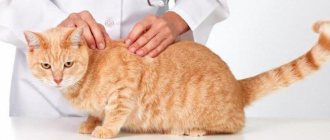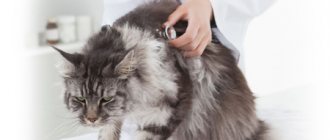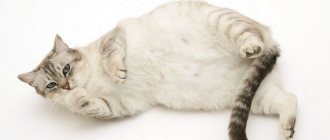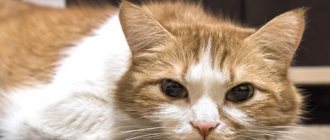The withers, also known as the scruff of the neck, is the place where the cervical spine ends and the dorsal spine begins. Its center is located at a point in front of the shoulder blades, which can be easily felt by hand, above the animal’s front paws - this place is located the same in all cats. If it is difficult for you to understand from the photo where the cat’s withers are, use a simple method.
Grasp the base of the front paws with one hand and move your hand upward, gradually squeezing it until you have a thick fold of skin in your fist. To check, press the hand with the captured skin against the cat's body - you should feel the hard bulges of the shoulder blades under it.
Where is it located?
The withers, sometimes simply called the “scruff,” are located behind the animal’s head - in the area where the neck meets the back. You can clearly determine the location of the withers by observing the mother cat. She carries her kittens from place to place, holding them by the scruff of the neck with her teeth.
Important! This method of carrying is only suitable for small kittens. If an adult is lifted by the withers, this can lead to injury. Below you can read about why you can still lift an adult cat by the scruff of the neck and how to do it as safely as possible.
Diagnostics
To identify the cause of the seal, it is recommended to contact your veterinarian, who will prescribe the following diagnostic tests:
- general clinical analysis of urine and blood, blood biochemistry;
- puncture of fluid from the cone;
- Ultrasound of the abdomen on the left or right side, where the tumor is located;
- palpation on the right and left of the neck to determine the symmetry of the tissues and the presence of compactions;
- X-ray of the neck.
For your information! When a puncture is performed, the liquid is sent for laboratory analysis. Can detect bacteria, viruses, fungi, and various toxins. For this purpose, PCR, ELISA, bacteriological culture, and microscopy are used.
Sometimes the doctor only needs one palpation to make an accurate diagnosis.
An ultrasound scan reveals the presence of liquid or solid contents of the lump. X-rays can show tissue damage and the presence of a tumor. Using palpation, the doctor determines the density of the formation. It can be connected to the capsule or be separate from it, moving like a ball.
Structural features
The withers have a bone base, which is formed by the first five thoracic vertebrae. Each vertebra has a spinous process, which differ from each other in height. That’s why the withers have such a special, curved shape.
Important! The skin in this area of pets is very thin and elastic. That is why it doesn’t hurt kittens when the mother cat grabs them by the withers with her teeth and carries them.
Under the skin there is a layer of fatty tissue. And underneath it are “hidden” different muscle groups - trapezius, rhomboids and others. There are no joints at the withers - they are located directly in the animal’s spine.
Interesting! The withers are “surrounded” by the neck and shoulder blades. They are attached to the individual’s body only by muscles and tendons. Therefore, this entire part of the body - the neck, withers and shoulder blade area - is incredibly flexible and mobile. This allows the cat to arch its back, jump to greater heights, and perform other maneuvers.
Why do you need to know the location of the withers?
The withers are the most suitable place for various types of medical procedures:
- applying antiparasitic drugs (for example, drops against fleas, helminths), since this area of the body is not accessible to the cat for licking the fur with his tongue, so he will not be poisoned by a toxic agent if applied correctly;
- administration of subcutaneous injections, since the skin here is thick with a minimum number of nerve endings, which reduces pain for the animal to almost zero during the injection (provided that it is done correctly). This explains the fact that most veterinary drugs are intended for subcutaneous administration, which is less painful compared to intramuscular injections.
Interesting Facts
Mother cats carry their kittens by the withers. Neuroscientists have been able to establish that in the cat’s cerebellum there is a zone that ensures balance and body position in space. When a cat takes a kitten by the withers, an impulse is sent to the cerebellum about the need to relax and not move. As a result, this method of transfer not only does not cause pain to the kitten, but also makes it calm down and hang in the characteristic “fetal position”, so the cat can transfer it to the desired place, even if it needs to run or jump.
How to influence a naughty pet using his own scruff?
Reflexes associated with the withers persist in cats throughout their lives. You cannot lift pets weighing 3–5 kg or more by the scruff of the neck, but you can use their natural instincts for educational purposes and in the training process.
The effect on the withers receptors allows you to control the behavior of even the most wayward and obstinate animals that show aggression towards humans.
By properly grabbing the scruff of the neck, you can prevent fights between cats, and also stop your pet from crapping in the wrong places or sharpening its claws on upholstered furniture. Experts consider such actions more effective than punishment. To re-educate your pet, you need to apply the following algorithm:
Firmly but gently grab the cat by the fold of skin on its neck
It is important to control your grip strength. The animal should not feel pain
We need to make him understand that he is not the strongest and the person in this house is the main one. Holding the scruff of the neck will force the pet to obey. Press the aggressor to the floor, continuing to hold him by the scruff of the neck. Say the prohibition word: “no”, “impossible”. You must speak clearly, firmly, but calmly, without raising your voice. Screaming in this case is unacceptable. It’s better to copy the behavior of a disgruntled cat and hiss at your pet. This signal has been familiar to him since childhood. This is how the mother made it clear to the baby that she did not like his behavior. Hold the cat until he relaxes. You can speak to him in a calm tone to help him calm down. Typically, pets need no more than 5 minutes to realize their guilt. Release after complete relaxation, praise, caress, removing your hand from the withers. For obedience, you can treat the obedient animal with a treat.
For some animals, one educational act is not enough to improve. In this case, the actions must be repeated if a similar situation arises. As a result of several repetitions, the pet will understand what the owner does not like.
Basic recommendations
Flea drops for cats are an effective and safe remedy that will quickly get rid of parasites. Today, such drugs are manufactured by various companies. When choosing, you should focus on the age and weight of your pet. Not all products are suitable for kittens and pregnant females. When using such drugs, the following recommendations must be observed:
- Before applying the product, carefully read the instructions. It tells you how many drops you will need and where it is best to drop them. Most often, it is enough to apply a couple of drops to the withers. Some products are recommended to be dripped at three points along the spine;
- Cat drops may not be effective if your cat gets wet after using them. Therefore, for several days after treatment, do not bathe the animal or let it go outside in rainy weather;
- Drops can also be used for preventive purposes. This is especially important if the cat is walking outside. In this case, it is sufficient to carry out the treatment once every six months;
- The product can only be applied to dry skin;
- Before using such products, it is better to consult a veterinarian, as they have some contraindications.
Following these recommendations will make the use of drops safe. The main thing is to start treatment as early as possible. Remember that a cat suffers greatly from a flea bite.
Allergy
Cat allergies are a common problem in veterinary dermatology. Recently, it has been increasingly diagnosed with increased skin sensitivity, when cats have a lot of hair coming out. The most common types of allergies include:
- Food intolerance to animal protein or a specific product (can be expressed in the form of periodic itching, scratching, loss of tufts of hair in different parts of the body and deterioration in the quality of the coat, tearing).
- Flea allergic dermatitis is a negative reaction to flea saliva in cats. It looks like severe itching, restlessness of the animal and significant uneven hair loss of the pet as a result of independent frequent licking.
- Intolerance to medications or a side effect from therapy for a chronic disease (oncology or hormonal imbalance).
In each specific case, treatment is selected individually. If you are allergic to food, the veterinarian prescribes a diet or develops a therapeutic diet. If there is a reaction to fleas, it is necessary to take all measures to eliminate them (treating not only the animal, but also the premises with special preparations all year round). And if your cat itches and goes bald due to medications, you will need to consult a veterinarian.
Attention! You should not try to independently treat allergic reactions in cats and give them human medications, such as Suprastin, Tavegil and analogues. Due to the side effects of medications and incorrectly calculated dosage “by eye,” the animal can be poisoned.
Preparing for treatment
Thus, now the reader knows where the cat’s withers are. How to find it if you need to use medicine is a simple question. However, when using the drops themselves, several important rules should be followed. Firstly, the cat should not be bathed for 2-3 days before using the medicine and for 2-3 days after that.
When performing the procedure for applying the drug, the cat should be gently held behind its back with your left hand. You should not administer medicine to an animal that is worried about something, has become playful or is angry. The cat may jerk during the procedure to escape, and the drops will fall too low on the body. As a result, the animal will subsequently be able to reach them. Wait until your pet calms down.
What to do if you suspect lichen in cats
The first thing to do if you suspect lichen in a domestic cat is to isolate the sick animal. There is no need to lock him in a cage or any other tight confined space. A separate room or loggia is suitable if it is warm.
Next, you need to urgently contact a veterinarian for an accurate diagnosis. Its goal is to obtain information about the cause and causative agent of lichen. Based on the research, the doctor will be able to choose the right therapy.
Important: it is strictly forbidden to bathe your pet if you notice signs of lichen. Together with the water, the lichen spores will spread to the entire body, thus increasing the affected area many times over. During the entire period of diagnosis and treatment of lichen in cats, the following recommendations must be followed:
During the entire period of diagnosis and treatment of lichen in cats, the following recommendations must be followed:
use separate dishes for a sick pet; if there are other animals in the house, then they need to be isolated, or better yet, removed from the premises for a while to prevent an epidemic; Carry out disinfectant cleaning more often, paying special attention to those places where your cat most likes to be; wash all bedding and rugs in a disinfectant solution; Treat upholstered furniture with a solution of water and vinegar. The following means are used for disinfection:
The following means are used for disinfection:
- quartz lamp - you need to turn it on in an infected room for 20-25 minutes;
- hot water with the addition of bleach or any other chlorine-containing bleach for washing linen and towels;
- hot steam for processing upholstered furniture;
- water with the addition of bleach, alcohol, iodine, vinegar, soap-soda mixture or 3-4% chlorhexidine for washing surfaces.
Remember that you need to wash not only the floor, but also, if possible, walls, doors, tables, baseboards, paying special attention to corners, crevices and other hard-to-reach places
Precautionary measures
Flea drops, like other specialized medications, are not toxic to your pet. Despite this, when using them, precautions must be taken so as not to harm the animal. These include:
- Before using the drops, inspect the skin where they are applied. If there are open wounds, scratches or other damage on it, then the drug cannot be applied;
- It is forbidden to handle kittens that feed on their mother's milk. The cat constantly licks her babies. At the same time, she will definitely lick off the drops applied to them. This may provoke negative consequences for her health;
- The kitten is allowed to use only specialized medications. Products for adults are not recommended for use;
- The drops used should not get on the cat's nose, eyes or mouth. If this happens, they should be washed off immediately with plenty of running water. After this, it is best to show the animal to a veterinarian;
- In some cases, drugs can cause an allergic reaction. If this happens, consult your veterinarian;
- Be careful not to lick the product off, especially if it is applied in multiple places along the spine. If this happens, observe your pet's behavior. At the first symptoms of poisoning, seek help from a specialist.
Compliance with such precautions will allow you not to worry about the health of the animal during treatment. Don't neglect them.
Benefits of drops
Flea and tick medications in the form of drops are used more often than others. This is due to a number of their undeniable advantages:
- High efficiency. As a rule, one treatment is enough to protect the animal from parasites for one or two months. In this case, the drug begins to act 20 minutes after application. You will notice this by the improvement in your cat's well-being. She will become more active, her appetite will increase;
- The drops are safe and, when used correctly, cannot harm the animal. But at the same time, we should not forget about precautions;
- Convenient to use. Most often, the drops are packaged in a small pipette designed for one use. With its help, you can apply the drug to a specific area of the skin;
- After using the product, the cat will not need to be bathed. You don’t have to wear an uncomfortable collar that your pet tries to take off.
Article on the topic: Flea drops for cats and kittens
Due to these advantages, drops are used more often than other means to combat parasites. Veterinarians recommend using them.
Why do you need to measure your cat's height?
Even if your cat leads a purely indoor lifestyle, she will need clothing in cold weather. This applies, first of all, to smooth-haired pets, who are especially cold on autumn days, when the central heating has not yet been turned on in the apartment.
You can sew a cat costume yourself or buy a finished product at a pet store. In both cases, so that the new thing does not turn out to be too small or large, you first need to take measurements from the animal.
In addition, height is measured in purebred animals that participate in exhibitions. Its value serves as the basis for calculating the index of elongation, massiveness, long-leggedness and other parameters of the animal. By comparing these values, a panel of judges determines whether a given specimen meets the required breed standards.
How to determine
A cat's withers are located on the back side of the spine. Its central part is a point in front of the shoulder blades, which can be easily felt with your fingers by placing them above the pet’s front paws.
If after the photo you still haven’t figured out where the cat’s withers are, you can use another method. To do this, you need to grab the base of the front paws with one hand and hold it up, squeezing until a thick fold of skin is clamped in your fist. After this, you need to press your hand with a fold of skin to the body, where the hard bones of the shoulder blades will be felt - this will be the scruff.
Despite the reduced sensitivity of the skin, this place on the animal’s body is quite problematic because it is located next to the neck. Any serious injury to this area can cause health problems for your pet. Such damage most often occurs during mating, since the cat holds the cat's scruff with its paws during the process. It doesn’t always come to wounds, but sometimes this happens, so it is important to pay attention to this point and, if necessary, take appropriate measures.











